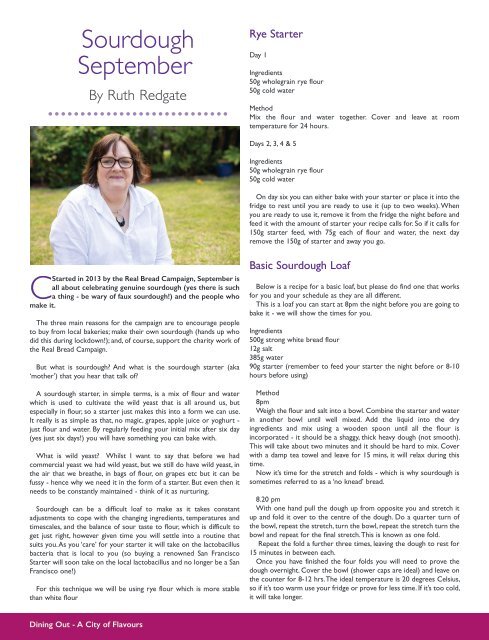Citylife in Lichfield September 2021
Our September edition magazine focusses on health and well being, giving you plenty of ideas of where you can go to relax, reinvigorate and recharge, especially after the stresses of the last 18 months. We also have usual wonderful mix of competitions, recipes, history features, local news stories from across Lichfield District and What's On events. There is no better way of relaxing than with our magazine so why not try some therapeutic yoga, put on some chilled out music, light some candles, mix a delicious fruit smoothie and have a read of Citylife September magazine - the perfect way to spend a relaxing afternoon!
Our September edition magazine focusses on health and well being, giving you plenty of ideas of where you can go to relax, reinvigorate and recharge, especially after the stresses of the last 18 months. We also have usual wonderful mix of competitions, recipes, history features, local news stories from across Lichfield District and What's On events. There is no better way of relaxing than with our magazine so why not try some therapeutic yoga, put on some chilled out music, light some candles, mix a delicious fruit smoothie and have a read of Citylife September magazine - the perfect way to spend a relaxing afternoon!
You also want an ePaper? Increase the reach of your titles
YUMPU automatically turns print PDFs into web optimized ePapers that Google loves.
Sourdough<br />
<strong>September</strong><br />
By Ruth Redgate<br />
............................<br />
Rye Starter<br />
Day 1<br />
Ingredients<br />
50g wholegra<strong>in</strong> rye flour<br />
50g cold water<br />
Method<br />
Mix the flour and water together. Cover and leave at room<br />
temperature for 24 hours.<br />
Days 2, 3, 4 & 5<br />
Ingredients<br />
50g wholegra<strong>in</strong> rye flour<br />
50g cold water<br />
On day six you can either bake with your starter or place it <strong>in</strong>to the<br />
fridge to rest until you are ready to use it (up to two weeks). When<br />
you are ready to use it, remove it from the fridge the night before and<br />
feed it with the amount of starter your recipe calls for. So if it calls for<br />
150g starter feed, with 75g each of flour and water, the next day<br />
remove the 150g of starter and away you go.<br />
CStarted <strong>in</strong> 2013 by the Real Bread Campaign, <strong>September</strong> is<br />
all about celebrat<strong>in</strong>g genu<strong>in</strong>e sourdough (yes there is such<br />
a th<strong>in</strong>g - be wary of faux sourdough!) and the people who<br />
make it.<br />
The three ma<strong>in</strong> reasons for the campaign are to encourage people<br />
to buy from local bakeries; make their own sourdough (hands up who<br />
did this dur<strong>in</strong>g lockdown!); and, of course, support the charity work of<br />
the Real Bread Campaign.<br />
But what is sourdough? And what is the sourdough starter (aka<br />
‘mother’) that you hear that talk of?<br />
A sourdough starter, <strong>in</strong> simple terms, is a mix of flour and water<br />
which is used to cultivate the wild yeast that is all around us, but<br />
especially <strong>in</strong> flour, so a starter just makes this <strong>in</strong>to a form we can use.<br />
It really is as simple as that, no magic, grapes, apple juice or yoghurt -<br />
just flour and water. By regularly feed<strong>in</strong>g your <strong>in</strong>itial mix after six day<br />
(yes just six days!) you will have someth<strong>in</strong>g you can bake with.<br />
What is wild yeast? Whilst I want to say that before we had<br />
commercial yeast we had wild yeast, but we still do have wild yeast, <strong>in</strong><br />
the air that we breathe, <strong>in</strong> bags of flour, on grapes etc but it can be<br />
fussy - hence why we need it <strong>in</strong> the form of a starter. But even then it<br />
needs to be constantly ma<strong>in</strong>ta<strong>in</strong>ed - th<strong>in</strong>k of it as nurtur<strong>in</strong>g.<br />
Sourdough can be a difficult loaf to make as it takes constant<br />
adjustments to cope with the chang<strong>in</strong>g <strong>in</strong>gredients, temperatures and<br />
timescales, and the balance of sour taste to flour, which is difficult to<br />
get just right, however given time you will settle <strong>in</strong>to a rout<strong>in</strong>e that<br />
suits you. As you ‘care’ for your starter it will take on the lactobacillus<br />
bacteria that is local to you (so buy<strong>in</strong>g a renowned San Francisco<br />
Starter will soon take on the local lactobacillus and no longer be a San<br />
Francisco one!)<br />
For this technique we will be us<strong>in</strong>g rye flour which is more stable<br />
than white flour<br />
Basic Sourdough Loaf<br />
Below is a recipe for a basic loaf, but please do f<strong>in</strong>d one that works<br />
for you and your schedule as they are all different.<br />
This is a loaf you can start at 8pm the night before you are go<strong>in</strong>g to<br />
bake it - we will show the times for you.<br />
Ingredients<br />
500g strong white bread flour<br />
12g salt<br />
385g water<br />
90g starter (remember to feed your starter the night before or 8-10<br />
hours before us<strong>in</strong>g)<br />
Method<br />
8pm<br />
Weigh the flour and salt <strong>in</strong>to a bowl. Comb<strong>in</strong>e the starter and water<br />
<strong>in</strong> another bowl until well mixed. Add the liquid <strong>in</strong>to the dry<br />
<strong>in</strong>gredients and mix us<strong>in</strong>g a wooden spoon until all the flour is<br />
<strong>in</strong>corporated - it should be a shaggy, thick heavy dough (not smooth).<br />
This will take about two m<strong>in</strong>utes and it should be hard to mix. Cover<br />
with a damp tea towel and leave for 15 m<strong>in</strong>s, it will relax dur<strong>in</strong>g this<br />
time.<br />
Now it’s time for the stretch and folds - which is why sourdough is<br />
sometimes referred to as a ‘no knead’ bread.<br />
8.20 pm<br />
With one hand pull the dough up from opposite you and stretch it<br />
up and fold it over to the centre of the dough. Do a quarter turn of<br />
the bowl, repeat the stretch, turn the bowl, repeat the stretch turn the<br />
bowl and repeat for the f<strong>in</strong>al stretch. This is known as one fold.<br />
Repeat the fold a further three times, leav<strong>in</strong>g the dough to rest for<br />
15 m<strong>in</strong>utes <strong>in</strong> between each.<br />
Once you have f<strong>in</strong>ished the four folds you will need to prove the<br />
dough overnight. Cover the bowl (shower caps are ideal) and leave on<br />
the counter for 8-12 hrs. The ideal temperature is 20 degrees Celsius,<br />
so if it’s too warm use your fridge or prove for less time. If it’s too cold,<br />
it will take longer.<br />
D<strong>in</strong><strong>in</strong>g Out - A City of Flavours


















